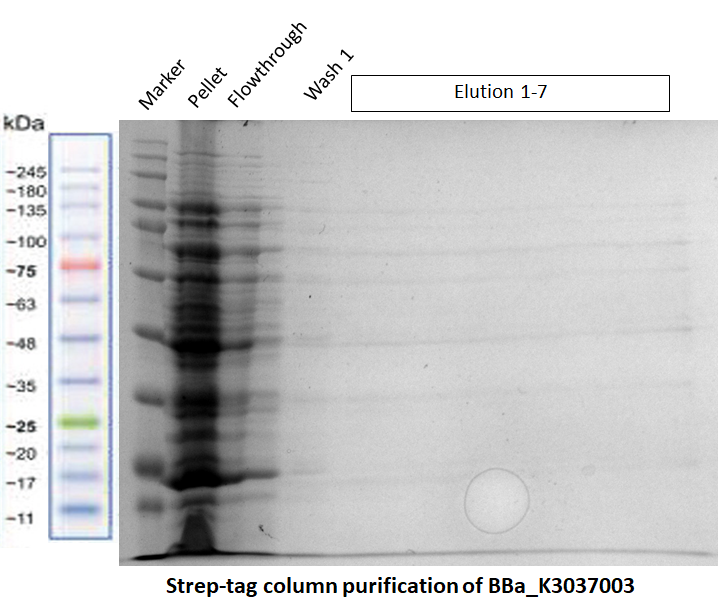Part:BBa_K3037003
Fusion protein dCas9 + HRP (MBP/dCas9/linker/HRP/Strep-tag)
| Fusion protein | |
|---|---|
| Function | Colour detection of specific DNA sequences |
| Use in | Escherichia coli |
| RFC standard | Freiburg RFC25 standard |
| Backbone | pSB1C3 |
| Submitted by | Team: TU_Dresden 2019 |
Contents
Overview
The TU Dresden 2019 team has designed this BioBrick in order to allow for the quick detection of specific DNA sequences of interest (more information).
The full construct is shown below, having each single marked part a specific function to optimize the full construct. The MBP and strep-tag allow purification via Amylose resin and via strep-columns, respectively. Additionally, the MBP enhances the expression of dCas9-fusion proteins and the linker helps in the folding process. The dCas9 identifies the sequence of interest and the HRP provides with a easy-detectable color-readout. More information regarding the biology, design and function of each basic part can be found here:
The single constructs were fused in PSB1C3 and PSB1A3 and finally the full construct was inserted into BBa_K3037000 vector for expression and characterization in Escherichia coli.
The weight of the protein was calculated based on the base pairs. 924 bp/3 = 308 amino acids, each amino acid weights as average 110 Dalton [1], so the final weight of approximately our construct is 230 kDa.
Biology
In order to find more information regarding the Biology and function of our final construct, please check the registries of the single parts:
MBP: BBa_K3037001
dCas9: BBa_K3037002
Linker: BBa_K3037004
HRP: BBa_K3037007
Strep-tag: BBa_K823038
Characterization
Outline
We performed the following characterization experiments:
1) Expression of our Full Construct (FC) in pOCC97 (BBa_K3037000): and testing the growth of E.coli.
2) SDS-PAGEs showing the expression of the full construct over time
3) Analysis of the expression with ImageJ
4) Characterization of the single parts of the full construct
Experiments in Detail
1) Expression of our Full Construct (FC) in pOCC97 (BBa_K3037000): and testing the growth of E.coli.
The full construct, once all the single parts were fused together, was cloned into our expression plasmid K3037000 (p0CC97). The correct insertion of our full construct into the plasmid was proven via restriction digest followed by agarose gel electrophoresis. For that, we performed a triple digest with PmlI, X and P and got several positive clones. On the right, the simulation of the digest in SnapGene is shown.
Furthermore, it was proven that the E. coli could grow normally after the induction of the fusion protein. For that, the development of the bacteria cultures was monitored by measuring the OD at 600 nm during different time points before and after induction with 1 mM IPTG.
As shown in the curve, the growth of the bacteria is not affected by the expression of the protein. Important to note here is that the expression of the full construct was performed in two slightly different POCC97 plasmids, that differ on their Ribosome Binding Site (RBS). Hereinafter they are going to be referred to as optimized and not optimized (read the registry page K3037003 to for more details regarding the difference between these two plasmids(LINK!)).
To go further, the expression of the full construct in pOCC97 at different temperatures was studied. For that, the optimized and not optimized pOOC97 were compared.

2) SDS-PAGEs showing the expression assay over time
After proving that the final construct was well inserted in our plasmid, the full construct was expressed overnight. The first expression was performed at 37°C for seven hours, induced with 1 mM IPTG. The result is shown below:
The same experiment was repeated several times at different temperatures and IPTG concentrations in both, the optimized and not optimized POCC97 to compare the best expression conditions. The results are shown in the Figures below.
Expression of Full Construct in pOCC97 not optimized at 18ÂșC and different IPTG concentrations
Expression of Full Construct in pOCC97 not optimized at 37ÂșC and different IPTG concentrations
Expression of the Full Construct in pOCC97 optimized at different temperatures and IPTG concentrations
3) Image analysis of the expression in the SDS-PAGEs with imageJ
3) Image analysis of the expression in the SDS-PAGEs with imageJ
Different induction concentration not optimized at 18ÂșC and at 37ÂșC
Not optimized at different temperature at 0.2 mM, 0.5 mM and 1 mM IPTG expression induction
Different temperature optimized 1mM
Different induction concentration optimizedat 18 degrees
Comparison optimized vs not optimized
Conclusion
Based on this analysis can be concluded that optimal conditions for the expression of BBa_3037003 are 18ÂșC and 0.5 mM IPTG. Also the optimization process is better than the not optimazed as the expression is more stable over time
4) Strep-tag column purification
This BioBrick include the Strep-tag BioBrick BBa_K823038.
This was used for make a purification of the fusion protein using the âExpression and purification of proteins using Strep-Tactinâ protocol of IBA Lifescience. The results of the following gel shows that the purification doesn't worked. We thought that this is because the Strep-tag that we used is meant to be used for Western Blots and not for column purification.
Sequence
- 10COMPATIBLE WITH RFC[10]
- 12INCOMPATIBLE WITH RFC[12]Illegal NheI site found at 2302
Illegal NheI site found at 5500 - 21INCOMPATIBLE WITH RFC[21]Illegal BglII site found at 381
Illegal BglII site found at 5742
Illegal BamHI site found at 4581
Illegal BamHI site found at 5314
Illegal XhoI site found at 5826 - 23COMPATIBLE WITH RFC[23]
- 25COMPATIBLE WITH RFC[25]
- 1000INCOMPATIBLE WITH RFC[1000]Illegal BsaI site found at 79
References
| None |




















